
Sal shows examples of intersection and union of sets and introduces some set notation.
- Subject:
- Mathematics
- Statistics and Probability
- Material Type:
- Lesson
- Provider:
- Khan Academy
- Author:
- Salman Khan
- Date Added:
- 12/29/2017

Sal shows examples of intersection and union of sets and introduces some set notation.

6.0002 is the continuation of 6.0001 Introduction to Computer Science and Programming in Python and is intended for students with little or no programming experience. It aims to provide students with an understanding of the role computation can play in solving problems and to help students, regardless of their major, feel justifiably confident of their ability to write small programs that allow them to accomplish useful goals. The class uses the Python 3.5 programming language.

This course provides an integrated introduction to electrical engineering and computer science, taught using substantial laboratory experiments with mobile robots. Our primary goal is for you to learn to appreciate and use the fundamental design principles of modularity and abstraction in a variety of contexts from electrical engineering and computer science.
Our second goal is to show you that making mathematical models of real systems can help in the design and analysis of those systems. Finally, we have the more typical goals of teaching exciting and important basic material from electrical engineering and computer science, including modern software engineering, linear systems analysis, electronic circuits, and decision-making.
Course Format
This course has been designed for independent study. It includes all of the materials you will need to understand the concepts covered in this subject. The materials in this course include:
Lecture videos from Spring 2011, taught by Prof. Dennis Freeman
Recitation videos, developed for OCW Scholar by teaching assistant Kendra Pugh
Course notes
Software and design labs
Homework assignments and additional exercises
Nano-quizzes and exams with solutions
Content Development
Leslie Kaelbling
Jacob White
Harold Abelson
Dennis Freeman
Tomás Lozano-Pérez
Isaac Chuang

This course provides ways to analyze manufacturing systems in terms of material flow and storage, information flow, capacities, and times and durations of events. Fundamental topics include probability, inventory and queuing models, optimization, and linear and dynamic systems. Factory planning and scheduling topics include flow planning, bottleneck characterization, buffer and batch-size analysis, and dynamic behavior of production systems.

The tools of probability theory, and of the related field of statistical inference, are the keys for being able to analyze and make sense of data. These tools underlie important advances in many fields, from the basic sciences to engineering and management.
This resource is a companion site to 6.041SC Probabilistic Systems Analysis and Applied Probability. It covers the same content, using videos developed for an edX version of the course.

This is an introduction to probability theory, designed for self-study. It covers the same topics as the one-semester introductory courses which I taught at the University of Minnesota, with some extra discussion for reading on your own. The reasons which underlie the rules of probability are emphasized. Probability theory is certainly useful. But how does it feel to study it? Well, like other areas of mathematics, probability theory contains elegant concepts, and it gives you a chance to exercise your ingenuity, which is often fun. But in addition, randomness and probability are part of our experience in the real world, present everywhere and yet still somewhat mysterious. This gives the subject of probability a special interest.

lecture slides for a calculus-based course in Introduction to Probability & Statistics; suitable for sophomore or junior level of an undergraduate program

The shell of a syllabus that hopes to incorporate many antiracist practices, in statistics.

The microscopic world is full of phenomena very different from what we see in everyday life. Some of those phenomena can only be explained using quantum mechanics. This activity introduces basic quantum mechanics concepts about electrons that are essential to understanding modern and future technology, especially nanotechnology. Start by exploring probability distribution, then discover the behavior of electrons with a series of simulations.
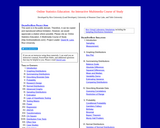
Introduction to Statistics is a resource for learning and teaching introductory statistics. This work is in the public domain. Therefore, it can be copied and reproduced without limitation. However, we would appreciate a citation where possible. Please cite as: Online Statistics Education: A Multimedia Course of Study (http://onlinestatbook.com/). Project Leader: David M. Lane, Rice University. Instructor's manual, PowerPoint Slides, and additional questions are available.
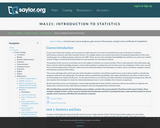
This course covers descriptive statistics, the foundation of statistics, probability and random distributions, and the relationships between various characteristics of data. Upon successful completion of the course, the student will be able to: Define the meaning of descriptive statistics and statistical inference; Distinguish between a population and a sample; Explain the purpose of measures of location, variability, and skewness; Calculate probabilities; Explain the difference between how probabilities are computed for discrete and continuous random variables; Recognize and understand discrete probability distribution functions, in general; Identify confidence intervals for means and proportions; Explain how the central limit theorem applies in inference; Calculate and interpret confidence intervals for one population average and one population proportion; Differentiate between Type I and Type II errors; Conduct and interpret hypothesis tests; Compute regression equations for data; Use regression equations to make predictions; Conduct and interpret ANOVA (Analysis of Variance). (Mathematics 121; See also: Biology 104, Computer Science 106, Economics 104, Psychology 201)

This course is an introduction to Markov chains, random walks, martingales, and Galton-Watsom tree. The course requires basic knowledge in probability theory and linear algebra including conditional expectation and matrix.
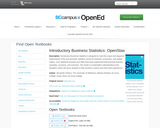
Introductory Business Statistics is designed to meet the scope and sequence requirements of the one-semester statistics course for business, economics, and related majors. Core statistical concepts and skills have been augmented with practical business examples, scenarios, and exercises. The result is a meaningful understanding of the discipline, which will serve students in their business careers and real-world experiences.

The book "Introductory Business Statistics" by Thomas K. Tiemann explores the basic ideas behind statistics, such as populations, samples, the difference between data and information, and most importantly sampling distributions. The author covers topics including descriptive statistics and frequency distributions, normal and t-distributions, hypothesis testing, t-tests, f-tests, analysis of variance, non-parametric tests, and regression basics. Using real-world examples throughout the text, the author hopes to help students understand how statistics works, not just how to "get the right number."
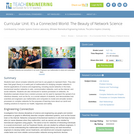
Students learn about complex networks and how to use graphs to represent them. They also learn that graph theory is a useful part of mathematics for studying complex networks in diverse applications of science and engineering, including neural networks in the brain, biochemical reaction networks in cells, communication networks, such as the internet, and social networks. Students are also introduced to random processes on networks. An illustrative example shows how a random process can be used to represent the spread of an infectious disease, such as the flu, on a social network of students, and demonstrates how scientists and engineers use mathematics and computers to model and simulate random processes on complex networks for the purposes of learning more about our world and creating solutions to improve our health, happiness and safety.
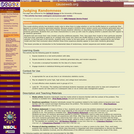
This model-eliciting activity has students create rules to allow them to judge whether or not the shuffle feature on a particular iPod appears to produce randomly generated playlists. Because people's intuitions about random events and randomly generated data are often incorrect or misleading, this activity initially focuses students' attention on describing characteristics of 25 playlists that were randomly generated. Students then use these characteristics to come up with rules for judging whether a playlist does NOT appear to be randomly generated. Students test and revise their rules (model) using five additional playlsits. Then, they apply their model to three particular playlists that have been submitted to Apple by an unhappy iPod owner who claims the shuffle feature on his iPod is not generating random playlists. In the final part of the activity, students write a letter to the ipod owner, on behalf of Apple, explaining the use of their model and their final conclusion about whether these three suspicious playlists appear to have been randomly generated.This lesson provides an introduction to the fundamental ideas of randomness, random sequences and random samples.

This text document lists detailed learning objectives for introductory statistics courses. Learning objectives are brief, clear statements of what learners will be able to perform at the end of a course.
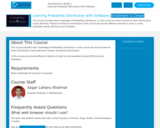
The Course includes the concept of probability distribution mainly binomial, poisson and normal distribution. In this course students will understood how to solve probability distribution problems using definition and open source software's like GeoGebra and excel
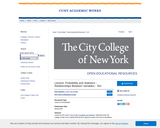
Lecture for the course "CS 217 – Probability and Statistics for Computer Science" delivered at the City College of New York in Spring 2019 by Evan Agovino as part of the Tech-in-Residence Corps program.
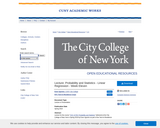
Lecture for the course "CS 217 – Probability and Statistics for Computer Science" delivered at the City College of New York in Spring 2019 by Evan Agovino as part of the Tech-in-Residence Corps program.